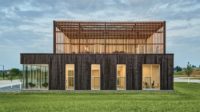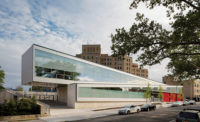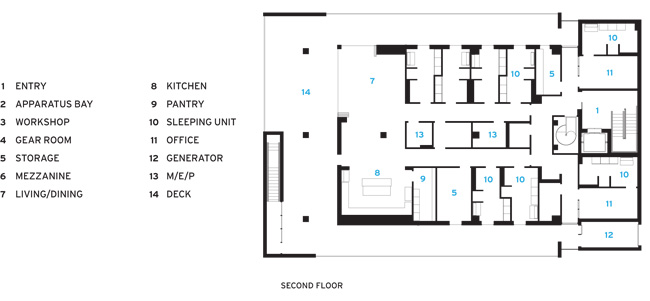Galveston Fire Station #4
Fighting Fire in Style: A coastal community ravaged by Hurricane Ike rebuilds one of its fire stations with an eye toward the next storm.


















Architects & Firms
Galveston, Texas
Don't let the miles of seaside kitsch fool you: Galveston, Texas, is no ordinary beach town. The community, precariously perched on a 27-mile-long island in the hurricane-prone waters of the Gulf of Mexico, is in an ongoing fight for its survival.
The results were catastrophic—80 percent of the houses were damaged, along with much of the city's waste-water management system and many emergency facilities like hospitals and fire stations. Armed with disaster-relief funding, Galveston has been slowly shoring up its infrastructure and buildings in preparation for the next storm.
Surrounded by uncertainty, the architects of a replacement fire station next to the Scholes International Airport have left nothing to chance. Located just four blocks from the Gulf, the new Galveston Fire Station #4, designed by HDR, is a rock-solid, two-story, 14,000-square-foot bunker with the look of an unpretentious yet polished beach house.
The station's vulnerable location in a high-risk flood zone but also adjoining an airport limited the architects' design choices. Living quarters and a critical operations center were elevated above flood levels but not too high to interfere with the adjacent airport's stringent height requirements.
The new building has a rectilinear concrete-frame structure, elevated about 2 feet above grade, and sits on 80 piles that descend 40 feet into the sandy soil. In keeping with Galveston's beach-town lifestyle, the design is simple, comfortable, and casual. On the first floor, the architects created a fairly spartan garage for the fire trucks and firefighting equipment, using minimal finishes and enclosing the open space with a translucent acrylic skin.
The second story, elevated 25 feet above sea level, is clad in white panels interrupted by long recessed terraces. At the core of the space are functionally designed sleeping quarters that share a living and dining area with an observation deck worthy of a luxury vacation house. “For the firemen, this is their home as well as their place of work—they're here for long periods of time,” says Jim Henry, the southern regional design director at HDR.
The sleeping units, shared by three people who rotate in eight-hour shifts, each have a stowaway bed and shower. However, they are purposefully narrow and compact—and television-free—to encourage the firemen to socialize in the bright and airy living and dining area organized around the lime-green kitchen.
On a quiet day, the firemen (currently there are no women) can sit on beach chairs and hang out on the partially enclosed balconies where floors, walls, and ceilings are ipe wood. “In addition to all the business, I wanted it to have all the relaxation of a beach house—a place where the firemen can come out, chill, and take in the scenery,” Henry says, referring to the panoramic views of the Gulf, the airport, and residential developments.
The firehouse's bold graphics and striking color palette (not red but neon green) draw from the mellow and casual ambience of the shore community. Nearby, Galveston's South Texas resort-style waterfront is dotted with Tiki-style fish restaurants and bars and culminates with a 100-foot-tall Ferris wheel on Pleasure Pier, whose LED lights blink into the night.
While the look of the building is simple and nonchalant, it's just for show. Fire Station #4 can readily switch into crisis mode to withstand a major hurricane, with wind speeds of 125 mph and a 20-foot storm surge. Poured-in-place concrete shear walls, which bookend the building, help. During a hurricane, fire trucks will be moved farther inland, and the doors may be opened to allow flooding of the ground floor.
Remarkably, the city was able to get wind and storm insurance for the second level, where all of the key operational equipment is located. “Probably, in a million years' time, an archeologist will wonder what this building was used for, because it will still be here,” says Steve Ratcliffe, an engineer at HDR. With a construction cost of $3.8 million, the fire station was a small project for HDR, a large, full-service firm. “People ask, 'Why would you do a fire station?' ” says Henry, “But resilience is a hot topic, and the lessons learned here apply at every scale.”
People
Formal name of building:
Location:
Completion Date:
Gross square footage:
Total construction cost:
Client:
Owner:
Architect:
Dallas office (Jim Henry):
Personnel in architect's firm who should receive special credit:
Architect of record:
Kathleen English, AIA, LEED AP BD+C, Managing Principal
Interior designer:
Engineers:
Civil: HDR, Inc.
Consultant(s):
Photographer(s): Size: 14,000 square feet Construction Cost: $3.8 million |
Products
Structural system
Exterior cladding
Roofing
Windows
Glazing
Doors
Hardware
Interior finishes
Lighting
Conveyance
Plumbing
Energy |













